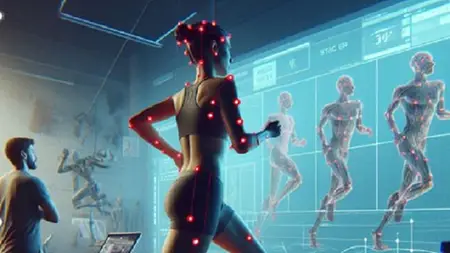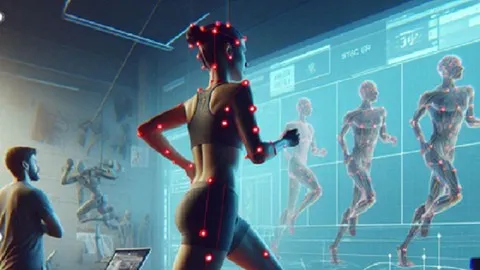Biomechanics And Rehabilitation Engineering
Published 2/2025
MP4 | Video: h264, 1920x1080 | Audio: AAC, 44.1 KHz
Language: English | Size: 1.93 GB | Duration: 2h 51m
Published 2/2025
MP4 | Video: h264, 1920x1080 | Audio: AAC, 44.1 KHz
Language: English | Size: 1.93 GB | Duration: 2h 51m
Restoring Movement, Enhancing Life
What you'll learn
human movement analysis, musculoskeletal mechanics,
biomaterials, assistive devices, prosthetics, orthotics
rehabilitation strategies
practical applications and hands-on learning
Requirements
No requirement
Description
Are you fascinated by the mechanics of the human body and passionate about helping people regain lost function? This comprehensive online course, "Biomechanics and Rehabilitation Engineering," provides a deep dive into the principles of biomechanics and their practical application in the field of rehabilitation. Across 15 engaging modules, you'll explore the intricate workings of human movement, learn how to analyze musculoskeletal systems, and discover the cutting-edge technologies used to restore and enhance mobility.This course is designed for students and professionals in engineering, biomedical engineering, kinesiology, physical therapy, and related disciplines, as well as anyone with a keen interest in the science of movement and rehabilitation. No prior advanced knowledge is strictly required; we'll build a solid foundation from the ground up.What you will learn:Foundational Biomechanics: Grasp the core concepts of statics, dynamics, kinematics, and kinetics as they apply to human movement.Musculoskeletal Mechanics: Analyze forces and moments acting on joints and bones, understand muscle mechanics and modeling, and delve into the biomechanics of major joints like the knee, hip, and spine.Biomaterials and Tissue Mechanics: Explore the properties of biomaterials used in rehabilitation and gain insight into the mechanical behavior of biological tissues like bone, cartilage, and muscle.Rehabilitation Engineering Applications: Discover the design and principles behind a wide range of assistive devices, including walkers, crutches, wheelchairs, prosthetics, and orthotics.Advanced Rehabilitation Technologies: Explore the exciting world of rehabilitation robotics and learn about the biomechanics of neurological rehabilitation for conditions like stroke and spinal cord injury.Practical Skills: Develop your abilities through hands-on exercises, case studies, simulations, and a final project where you can apply your knowledge to real-world rehabilitation challenges.Course Highlights:Comprehensive Curriculum: 15 modules covering all essential aspects of biomechanics and rehabilitation engineering.Engaging Learning Experience: Clear explanations, illustrative diagrams, real-world examples, and interactive exercises.Practical Focus: Emphasis on applying biomechanical principles to the design and analysis of rehabilitation solutions.Expert Instruction: Learn from experienced professionals in the field.Flexible Online Learning: Study at your own pace and on your schedule.Who should take this course?Undergraduate and graduate students in engineering, biomedical engineering, kinesiology, physical therapy, and related fields.Professionals working in rehabilitation, healthcare, or related industries.Anyone with an interest in biomechanics, human movement, and assistive technologies.By the end of this course, you will be able to:Analyze human movement using biomechanical principles.Understand the mechanics of musculoskeletal systems.Design and evaluate assistive devices, prosthetics, and orthotics.Apply biomechanical principles to rehabilitation strategies.Contribute to the development of innovative solutions for restoring movement and enhancing quality of life.
Overview
Section 1: Foundations of Biomechanics
Lecture 1 Introduction to Biomechanics
Lecture 2 Human Anatomy and Physiology for Biomechanics
Lecture 3 Motion Analysis Techniques
Section 2: Musculoskeletal Biomechanics
Lecture 4 Statics of Musculoskeletal Systems
Lecture 5 Dynamics of Musculoskeletal Systems
Lecture 6 Muscle Mechanics and Modeling
Lecture 7 Joint Biomechanics
Section 3: Biomaterials and Tissue Mechanics
Lecture 8 Introduction to Biomaterials
Lecture 9 Tissue Mechanics
Section 4: Rehabilitation Engineering Applications
Lecture 10 Assistive Devices
Lecture 11 Prosthetics
Lecture 12 Orthotics
Lecture 13 Rehabilitation Robotics
Lecture 14 Neurological Rehabilitation
Section 5: Advanced Topics and Projects
Lecture 15 Advanced Topics and Project
Undergraduate students in engineering, biomedical engineering, kinesiology, physical therapy, and related fields.,Also suitable for professionals looking to expand their knowledge in this area.



